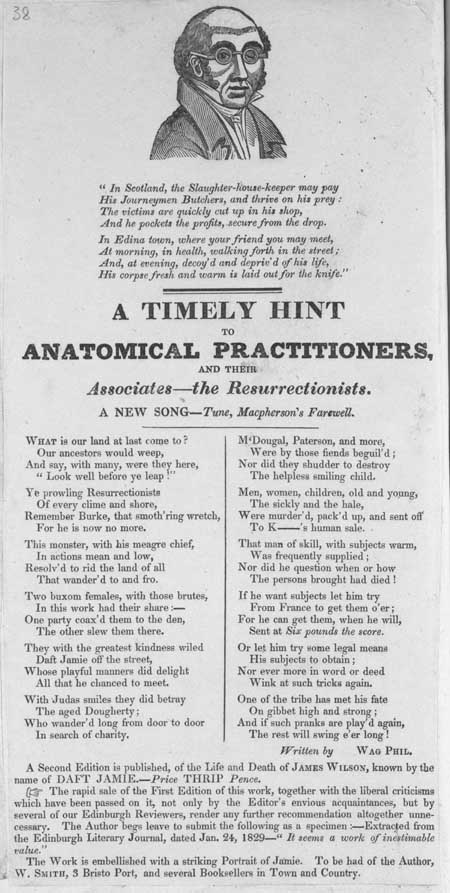
 |
| home | background | illustrations | distribution | highlights | search & browse | resources | contact us |
Broadside ballad entitled 'A Timely Hint to Anatomical Practitioners and their Associates - the Resurrectionists' |
CommentaryVerse 1 begins: 'What is our land at last come to? / Our ancestors would weep'. This song was written by 'Wag Phil' to the tune 'MacPherson's Farewell'. There is an introductory verse to the piece and a woodcut illustration of Dr Robert Knox, the Edinburgh anatomist. The broadside also includes at the end an advertisement for a second edition of the book 'The life and death of James Wilson, known as Daft Jamie'. This edition could be bought from W. Smith of 3 Bristo Port, Edinburgh. The text of this song relates to the heated public debate about the illegal trade in corpses for dissection in medical teaching. Before the Anatomy Act of 1832, only the corpses of executed murderers could legally be used for dissection. The supply of fresh corpses failed to meet the growing demand from anatomists, desperate to meet the needs of their fee-paying students. This shortage had resulted in the crime of 'body snatching' where 'resurrectionists' would dig up cadavers out of fresh graves and sell them to medical schools. As a renowned centre for the study of medicine, Edinburgh had a thriving trade in illegally-procured corpses. Anatomists like Robert Knox turned a blind eye to where the bodies came from and were willing to pay handsomely for fresh specimens. William Burke and William Hare were not resurrectionists but notorious serial killers, who lived in Edinburgh's West Port area. The Irishmen hit upon the idea of murdering travellers and vulnerable people they encountered so that they could sell the bodies for dissection to Knox. The two men and their wives were arrested in November 1828, after the police became suspicious about the death of an old woman at Burke's lodgings. Hare turned King's Evidence in return for immunity from prosecution. His evidence was used to secure the conviction of Burke, who admitted to having killed, in partnership with Hare, at least 16 people that year. Their most prominent victim was the young man James Wilson, 'Daft Jamie,' a well-known figure in Edinburgh's Old Town. Burke was hanged on the 28th January 1829 in front of a large, raucous crowd in the Lawnmarket. The writer of this song, 'Wag Phil', uses the grisly fate of Burke's victims and Burke himself (after his execution his body was dissected) to serve as a warning to 'anatomical practitioners' and their associates, the resurrectionists, to stop their 'pranks', otherwise they will find themselves swinging from a gibbet.
|
Probable date published:
1829 shelfmark: Ry.III.a.6(038)

|